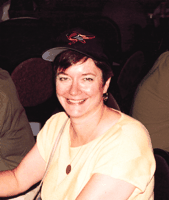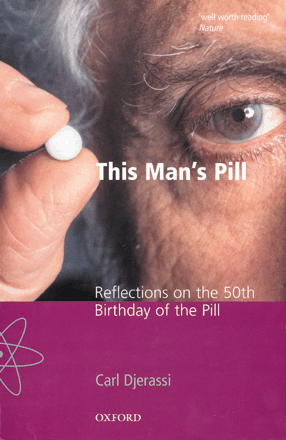A Lot to Swallow
- Christie Carrico, PhD
This Man’s Pill.
Carl Djerassi.
New York:
Oxford University Press;
2001. 308 pages. $16.50.
ISBN: 0198606958 (Pbk)
Carl Djerassi wrote This Man’s Pill to commemorate the fiftieth anniversary of the first oral contraceptive, a drug in whose development he had been instrumental. Djerassi has been many things in his lifetime—an organic chemist, a biochemist, a teacher, the winner of some of the most prestigious scientific awards in the world (Priestly Medal, National Medal of Science, National Medal of Technology), the writer of more than 1200 scientific manuscripts and numerous pieces of fiction (Cantor’s Dilemma, The Bourbaki Gambit), a playwright (Oxygen, An Immaculate Misconception), an entrepreneur (Syntex), and a patron of the arts (Djerassi Resident Artists Program). Djerassi does not hesitate to recount these activities, in great detail, in this particular opus.
The book is divided essentially into thirds, only the first of which is about the history, discovery, and advent of the birth control pill. Another third focuses on the global politics of contraception. The rest of the book comprises Djerassi’s autobiographical musings. Djerassi attempts to weave the theme of the impact that the Pill had on his life throughout the story, but much of this seems a stretch. The reader is better advised to confront This Man’s Pill as two separate but related books, one a historical and political account of the Pill, and the other the autobiography of a fascinating (even to himself) man.
The birth control pill was “born” on October 15, 1951, in Mexico City, at a small company called Syntex. Djerassi cleverly uses the analogy of conception, birth, and genealogy to describe the history of the Pill, including his “maternal role.” The various scientists who contributed to the concept and development of the oral contraceptive are assigned roles such as aunt, father, grandfather, etc. The Pill was “conceived” in the 1920s in Austria, at the University of Innsbruck, where physiology professor Ludwig Haberlandt implanted the ovaries of a pregnant rabbit into a female rabbit host, which consequently became infertile for many months, despite multiple attempts to breed—well, like a rabbit. Haberlandt recognized the potential of this result for human contraception, and conducted experiments in mice with orally administered “infecundin,” an extract of corpus luteum. Shortly after Haberlandt’s death, at age 47, pure progesterone was isolated in Germany, Switzerland, and the US. Although contraceptive, pure progesterone could not be taken orally, and work in this area slipped into scientific oblivion for twenty years. For his efforts, Haberlandt is given the designation of “grandfather of the” Pill.
In the 1930s and 1940s, Russell Marker described the relatively simple high-yield conversion of diosgenin (present in certain edible yams found in Mexico) into progesterone. Marker had been working with other natural products, attempting to convert them into progesterone, but became disillusioned when Parke-Davis and Merck refused to consider the industrial applications of his work. He moved to Mexico, where he became one of the founders of Syntex. He left that company within a year due to accounting irregularities (i.e., they failed to pay him any salary even though he had produced over 30 kilos of progesterone). Both of these ancestors of the Pill, as well as many others that followed, were very interesting, and in some cases downright quirky, and Djerassi details both their scientific contributions and their personal peculiarities.
Djerassi himself went to work for Syntex in 1949, and two years later, on October 15, his laboratory completed the first synthesis of norethindrone (17α-ethynyl-19-notrestosterone). The product was shipped to Wisconsin, where Elva Shipley first established its oral progestational activity. Based on Shipley’s observations, Djerassi sent it to several endocrinologists and clinicians, including Roy Hertz at the National Cancer Institute, Gregory Pincus at the Worcester Foundation, and Edward Tyler of the Los Angeles Planned Parenthood Center. No story is complete without intrigue and politics, and there are plenty of these surrounding the clinical development of the first oral contraceptive. In Djerassi’s account, the tensions among scientists and the pharmaceutical industry extend into the global politics of contraception.
Once he has covered the history and chemistry of the Pill, Djerassi discusses the philosophy of contraception around the world and over time. In his first play, An Immaculate Misconception, he addresses some of the potential ramifications of his and others’ work on the Pill. He also describes how the Pill’s impact on science and society led him to think more broadly about ethical issues that affect science, which led him to write the novels Cantor’s Dilemma and The Bourbaki Gambit.
Much of the remainder of the book deals with his marriage and divorce, his transition to a teacher of human biology and subsequently science-in-fiction, and the tragic suicide of his daughter. Through his daughter, he developed an interest in the art world, and while I found his pontification about his extensive art collection rather heavy-going, I applaud the efforts he and his family have made to create a nurturing environment for aspiring artists.
Djerassi certainly knows better than any person alive the social and political impact of the Pill. In the final chapter of the book, he moves away from autobiography and talks about the fortuitous timing of the birth of the Pill along with the change in the political environment that ten years later would probably have prevented the Pill from coming to market. He also explores the current focus on adverse effects of oral contraceptives and their latter-day offspring, hormone replacement therapy.
Carl Djerassi has accomplished more in each aspect of his career than most accomplish in an entire lifetime. He can thus be forgiven for somewhat frequently blowing his own horn. (After all, it is an autobiography.)
Carl Djerassi was born in Vienna and educated in the US. He is Professor of Chemistry at Stanford University, and he is a member of both the National Academy of Sciences and the American Academy of Arts and Sciences. He has received eighteen honorary degrees, the National Medal of Science (for the first synthesis of a steroid oral contraceptive), and the National Medal of Technology (for promoting new approaches to insect control). He has continued to write extensively since the publication of This Man’s Pill, and more about Djerassi can be found at www.djerassi.com.
- © American Society for Pharmacology and Experimental Theraputics 2005

Christie Carrico, PhD, is Executive Officer for ASPET.





